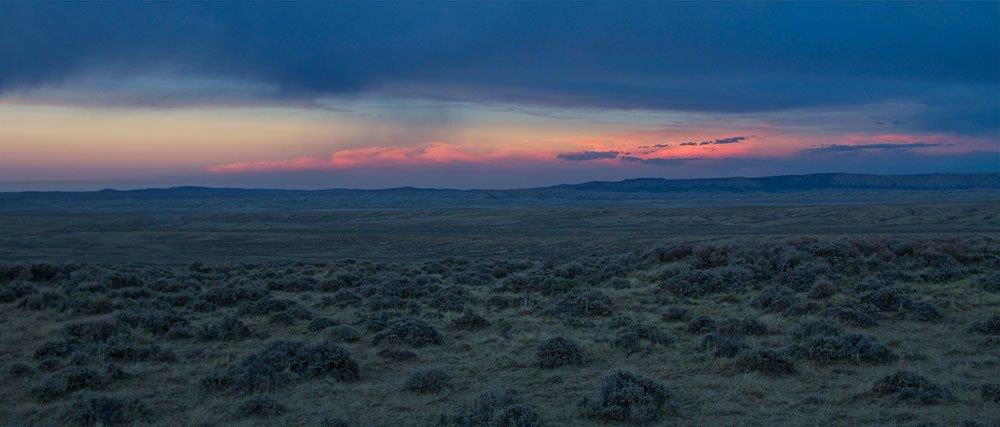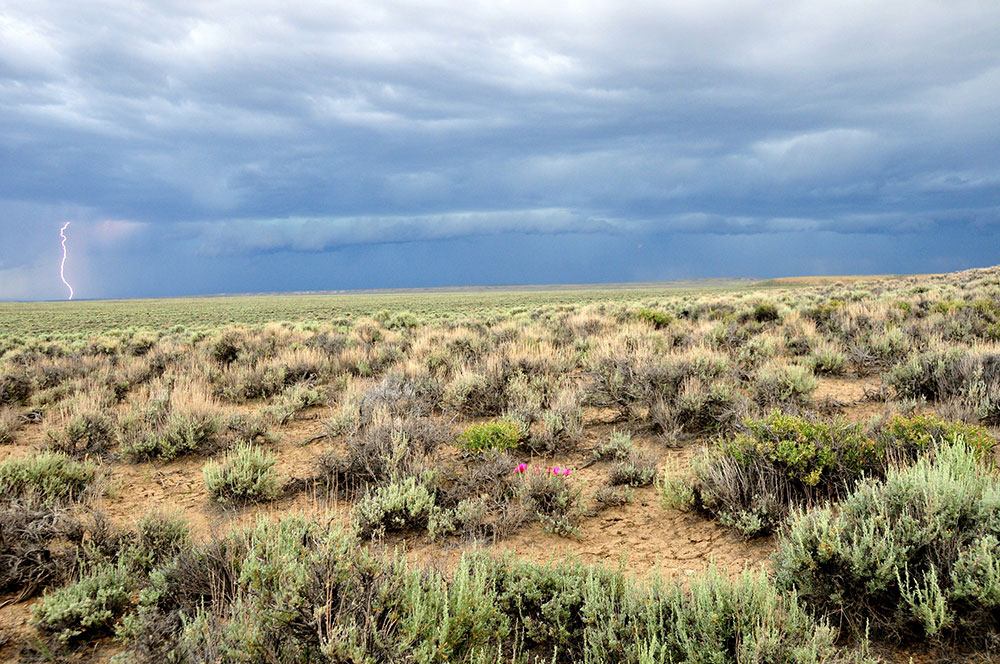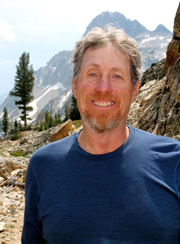A cattle rancher surveys his land, gazing across a vast expanse of the western range. The land surges and rolls, lifting sharply in waves of stone, and receding softly onto the open plains. Before him is a living sea—a Sagebrush Sea, as vast and as variable as any ocean.
Each year, ranchers set sail on the Sagebrush Sea, and by grazing livestock, they convert relatively low-valued plants into higher-quality protein. Like sea captains, ranchers must deliver their cargo in good shape while maintaining their capacity to make the next voyage, navigating the ever-changing conditions of the high seas. These wildly variable conditions—wind and currents on the ocean, rainfall and temperature on the land—are both influential and unpredictable. A salty sailor is one who learns how to respond to these changes and navigate conditions that would sink a less canny sailor’s ship.
On the Sagebrush Sea, success depends on the flexibility the rancher is afforded to adapt his management to changing environmental conditions. Regulations that restrict a rancher’s ability to maneuver his ship in response to these changes can threaten the voyage. For instance, policies that restrict the duration or season of grazing—known as “time” and “timing”—can undermine the very management practices that are needed most. Strict limits on the frequency or intensity of grazing can also hinder what we now understand to be proper rangeland management.
Today, federal grazing policies assume we can navigate the Sagebrush Sea with a static view of the natural world. In effect, we are locking the captain’s sail-set and tiller position based on the average wind speed and direction of the South Pacific. But averages are useless on the Sagebrush Sea, just as they are on the open seas, and every voyage is doomed without the capability to constantly adjust to the vagaries of nature.
Moreover, the terms and conditions of federal grazing permits are based on rangeland assessments made infrequently on small plots that are then extrapolated across vast regions. It would be like peering over the gunnels to observe the waves at a single moment and assuming this observation will predict sea conditions over the next year, or even the next decade.
Making matters worse, many ranchers lack the basic instruments of navigation—the feedback mechanisms necessary to understand and adapt to changes on the landscape. They lack the equivalent of a compass to tell them which direction their enterprise is heading. They lack a sextant to inform them of their position and to assess just how far they have deviated off course.
The reality is that we are blindly sailing the Sagebrush Sea, with rudder and sails in a locked position—and we have little or no way to understand which direction we’re heading. Until now.
The Background
“There is perhaps no darker chapter nor greater tragedy in the history of land occupancy and use in the United States than the story of the western range,” claimed a 1936 report by the Interior Department. Since much of the Sagebrush Sea was never homesteaded, the land remained largely under public ownership. As a result, a textbook example of the “tragedy of the commons” unfolded, as destructive grazing practices gradually eroded public rangelands.
In response, the federal government created new standards designed to prevent overuse of the western range. The federal rangeland was partitioned into public grazing allotments administered by the Bureau of Land Management or U.S. Forest Service. Ranchers lease the allotments and graze livestock based on ten-year permits with fixed terms and conditions that dictate the time, timing, and number of livestock that can be grazed on each allotment. Every five to ten years, rangeland assessments are made to re-set stocking rates for each allotment.
In the 1970s, a broader vision of rangeland health began to emerge—one that included recreation, watershed health, species protection, and other environmental values. New groups were afforded a seat at the rangeland planning table through policies such as the National Environmental Policy Act, which requires environmental assessments and public input for management actions on federal lands.
These new definitions of rangeland health, however, did not include the development of new tools that could adequately measure them. As a result, ranchers today face a growing set of management demands but are left adrift without the basic instruments to chart a course for long-term land stewardship.
The reality is that we are blindly sailing the Sagebrush Sea, with rudder and sails in a locked position—and we have little or no way to understand which direction we’re heading. Until now.
And there’s yet another problem: The fixed terms and conditions of federal grazing permits often do not provide ranchers the flexibility needed to adapt to the unpredictability of the Sagebrush Sea. Even a low level of rangeland use does not necessarily stop overgrazing. A good manager must continually adjust the number of livestock, the amount of time livestock are allowed to graze, and the location and season that grazing occurs. Understanding the relationship between these management tenets and their effects on the land requires practice—as well as a feedback system that provides the information necessary to constantly adjust our sails.
New Directions
I have sailed the Sagebrush Sea many times. For more than 40 years, I worked as a ranch manager and consultant for many of the largest ranch enterprises in the United States. For the last 18 years, I have worked to develop rangeland assessment technologies that provide better measurement tools to help other sagebrush captains navigate the dynamic conditions of the Sagebrush Sea.
What I have discovered over my career is this: Although the sagebrush ecosystem is extremely dynamic, sagebrush captains can adjust their sails and rudder to the waves of change that surround them. With the right tools and the freedom to use them, they can harness these natural forces to promote the long-term health of the land. This is what is known as results-based, adaptive management.
Due to the history of the western rangeland, overgrazing has unfortunately been oversimplified to mean “too many cows.” This view has led to policies and conventions that fixate on reducing livestock grazing, and thus restrict ranchers’ abilities to implement adaptive grazing management. We now know, however, that this simplistic view is wrong.
In reality, grazing is simply the removal of tissue from a living plant. As long as a plant is free to regrow what has been removed, the type or number of organisms removing that tissue is of little consequence to the plant during the growing season. The situation only becomes “overgrazing” when the plant is not able to replace the lost tissue during the growing season because of repeated grazing before full recovery. But this has nothing to do with the number of grazing entities. One goat, one grasshopper, one lawn mower, one wild mustang, one cow, or one elk chewing a blade of grass can all have the same effect on a plant. The proper management approach is the same: Leave the plant alone until it regrows all of the removed tissue, however long that takes. In some places, this can take more than a year.
All rangeland plants evolved with defoliation, even severe defoliation under insect swarms, hail storms, and wildfires. Over the ages and around the world, grazing is the primary form of defoliation on rangelands. Grazing is integral to plant health but must be balanced with adequate rest periods. Plants respond to grazing by producing new growth, beginning a cycle that converts sunlight into biomass. But the process of generating new growth is taxing. If animals are not moved onto new pastures at the appropriate time, they will continue to eat their preferred plants as they produce new growth. This can prevent plants from recovering and eventually kill them.
These basic facts are why the timing of grazing is so important—to ensure that plants, once eaten or trampled, have time to recover. When done at the right times, grazing can strengthen and stimulate plants to produce even more tissue. If plants are allowed time to recover, then the initial damage of grazing has much the same strengthening effect as muscles torn down through exercise and then allowed to rest. Over time, the cycle between use and rest increases the ecosystem’s productive capacity.
The basic task of the rangeland manager, therefore, is to achieve a proper balance between grazing and recovery. And, like sailing, it is simple in the abstract but frustratingly complex in practice. Among the most important parameters an experienced manager must account for are season of use (timing), length of use (time), and intensity of use (stocking rate). These factors help the rancher determine the duration of the rest plants need to recover.
Along with this comes the recognition that grazing during the growing seasons of plants has the most severe effect and most influences the need for recovery. When plants are actively growing, it is the growing points that are most likely to be grazed, which can have dramatic implications on a landscape. The active growing season is the only time that plants can make new leaves and recover from the demands of maintaining themselves through the dormant seasons, when the lack of water and temperatures don’t allow them to use sunshine for photosynthesis. This active growing season is short, usually only May and June, and it is the only season of the year in which plants can store up nutrients to be used to maintain themselves during dormancy. Pastures that have been used during the active growing season have to be rested over this same period in subsequent years to ensure that they recover. The use or rest of a pasture during any other season of the year besides the active growing season is of little importance to long-term plant heath.
The most critical insight from this basic understanding is that the timing of grazing is more important than the intensity or amount of use. This insight, however, runs counter to most federal grazing policies, which overemphasize stocking rates. As a result, the proposed solution to rangeland degradation is almost always to “de-stock.” While this might be necessary at certain times and places, it is equally likely to be detrimental to rangeland health. Too much rest can be damaging to plant health. Old plant growth can begin to shade out young shoots, and plants begin to die from a shortage of sunlight. Strange as it may seem, intensive, short-term grazing might be exactly what’s needed to rejuvenate plant health in some cases.
Today, federal rangelands are often considered to be in poor condition. But this is not because there are too many cows. In fact, the amount of livestock grazing on federal lands declined by more than half since the 1950s. Instead, a lack of understanding of the interactions between time, timing, and stocking rates is the primary reason federal rangelands generally remain in bad shape.
The Sextant and the Compass
And here lies the crux of the great debate over the western range: We lack the tools necessary to measure our position on the Sagebrush Sea and to objectively assess the effects of our management practices. In essence, we lack a sextant and a compass that can accurately gauge the swells and tides of an ever-changing ocean. Such tools would assure a flow of information that would allow sailors of the Sagebrush Sea to adapt and improve in the face of new conditions and new demands upon the land.
Until recently, our ability to measure and monitor changes on rangelands have been limited in time and space. Traditional field-based monitoring is not done frequently enough or on a large enough scale to account for the tremendous variations on this ever-changing sea. As a result, our policies are focused on inputs rather than outcomes—the number of livestock grazing rather than measurements of vegetation, water quality, and other public benefits provided by western rangelands.
We lack the tools necessary to measure our position on the Sagebrush Sea and to objectively assess the effects of our management practices. In essence, we lack a sextant and a compass that can accurately gauge the swells and tides of an ever-changing ocean.
I have spent the last 18 years developing a monitoring assessment technology that uses high-resolution photography and remotely sensed imagery to evaluate rangelands and their responses to specific management practices. The assessment protocol, recently published in the journal Ecological Indicators, models the percent of bare ground, shrub, and other vegetation cover across sagebrush landscapes in the West. It provides accurate information on rangeland conditions at scales ranging from millimeters to kilometers across multiple decades, costs one-tenth the amount of traditional methods, and can be readily assessed by computer or smartphone.
This technique has great potential to help us understand land cover change and rangeland health in a way that had not been available before. Ranchers can use this method to evaluate past management practices based on their effectiveness in altering basic cover components of rangelands. They can also develop improved management strategies, providing a valuable tool to assess public grazing allotments for land health, or even to gauge habitat quality for threatened species like the greater sage grouse.
This protocol vastly improves upon our current field-based monitoring techniques, which are used to measure individual plant species on a small plot and extrapolate the findings over enormous landscapes. Assessing rangeland conditions at a landscape level consistently is the only legitimate way to understand the effects of land management decisions. This feedback system, combined with a manager’s experiential knowledge of the landscape, allows managers to regularly assess conditions and chart a proper course on the Sagebrush Sea.
Future Voyages
Today’s rangeland assessment methods are flawed because they fail to recognize that nature is dynamic and, at times, reliant upon disturbances to promote health. Furthermore, many assessments of rangeland health are based on the outdated assumption that there is a “natural” plant community for each soil type. By knowing the correct endpoint, the theory goes, rangeland health can be assessed relative to its proper plant community. But these static endpoints are an illusion, and they have long been disputed in ecological science.
Flexible, results-based grazing policies are the only way to allow sagebrush captains sufficient latitude to navigate an unpredictable and variable environment and also achieve the results that the public cares about. We don’t need to dictate how our rangelands are improved. We just need to determine the desired results, establish the proper incentives, and step back to give rangeland managers the flexibility to achieve those results on their own.
We now have the tools to measure important land health characteristics in great detail across time and space. We can formulate precise and measurable goals for our rangeland ecosystems—whether it’s more riparian area, fewer wildfires, or more sage grouse. Ranchers can then figure out how to best achieve these goals. The simplest incentive is to allow ranchers to implement the practices best suited for the dynamic landscapes they inhabit, while holding them to objective, measureable outputs that ensure the rangeland conditions we care about are provided and protected.
This is possible today. But there needs to be regulatory flexibility to achieve these goals, given the tremendous unpredictability and dynamics of the Sagebrush Sea.
It is time for a serious examination of the state of modern rangeland management on the Sagebrush Sea. New technologies to provide adequate feedback and flexible administration, coupled with the long-term view of the ranchers who live and work there, could offer the public the kind of management required to manage this vast resource. Ahead, full sail.





